This weekend I’m finishing up my two ‘Pretty, Pretty, Princess‘ projects. The first is a completely hand-sewn silk taffeta 18th century petticoat, to go with a matching robe à la française that I’ll be making for ‘Robes & Robings‘.
I’ve had the fabric for this petticoat in my stash for three years now. It came up at Global Fabrics, and it was just so gorgeous, and so perfectly 18th century, that I couldn’t resist it. At the time, it was the most expensive fabric I had ever purchased (I think I paid $30 a metre for it). I held it, and hoarded it, and waited for the right time to use it.
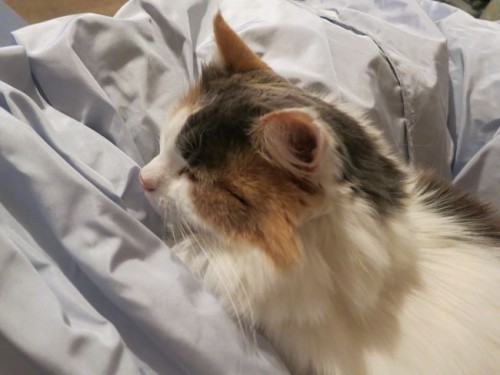
I used a tiny bit of it in making Shell’s wedding dress, but I was selfish and refused to let her have the whole lot for her frock (really though, I made the right choice. Taffeta would have been too stiff and formal for her wedding, and unlike the grey silk crepe, would have been completely ruined by a bit of damp and mud).
Would you like to see how amazing the taffeta is? I was working on the petticoat, tossed it on the chest at the foot of our bed to do something else, and came back to find this sculpture:
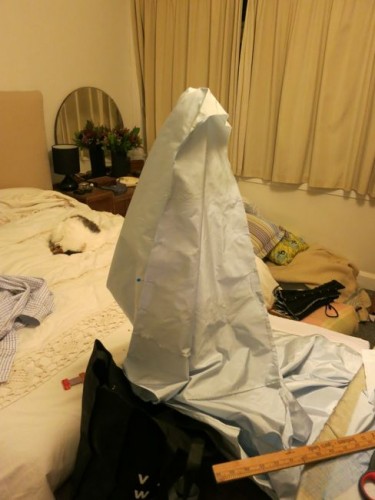
Yep. That is almost three feet of taffeta, with no support, just hanging out, checking out the view, standing sentinel for Felicity, just as I threw it an hour earlier!
I’m still working on the final design for the Robe à la Française, but I’m basing the trim for the petticoat on Ramsay’s beautiful portrait of Queen Charlotte with her two sons.
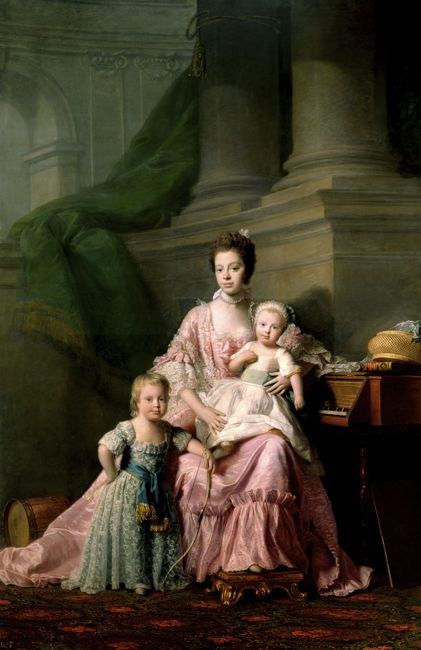
Charlotte of Mecklenburg-Strelitz, Ramsay, 1765
I love this portrait, and Queen Charlotte is another of my favourite princesses (definitely in the top 10). When she was married the marriage negotiations openly admitted that her education had been ‘mediocre’, but she was clearly an intelligent, curious, woman, who continued to learn and expand her mind all her life, becoming an amateur botanist, and supporting the arts, and numerous charities, particularly those for women. Perhaps because her own education had been so spotty, she was very interested in the education of women, ensuring that her own daughters were well educated, and perhaps because she had been married off so young and had so many children (15!), and because her sister-in-laws marriages had been so disastrous, she refused to let her daughters marry young (this one she carried a bit too far). She was also nice, which is a vastly underrated virtue.
Finally, I emphasise with the description of Charlotte as being “timid at first but talks a lot, when she is among people she knows.” Nobody ever expects me to be shy, because I’m such a confident, natural public speaker, but I’m very reserved until I know people well.
Looking at Ramsay’s portrait, I love the simplicity of the petticoat, with just one deep ruffle that really allows the fabric to take centre stage (and oh, wouldn’t I love some rose pink silk-satin to recreate the gown exactly!). I think the ruffle will move beautifully in the taffeta.
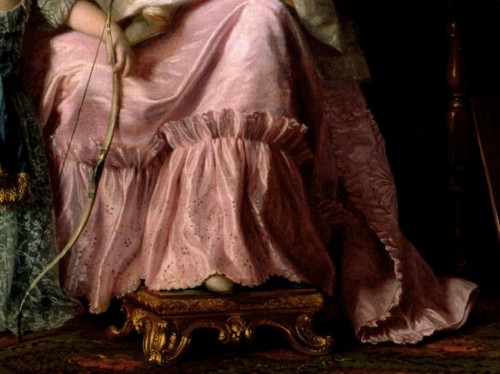
Charlotte of Mecklenburg-Strelitz by Ramsay, 1765 (detail)
I’m trying to figure out how to replicate the lacy pattern punched into the ruffle, as I don’t have the correct 18th century equiptment to create it. Alas, I may have to forgo the lacy holes.
Anyway, on to the nitty-gritty. What have I done so far?
My petticoat is three lengths of fabric sewn together with hand-stitched seams, one 70cm long and two full widths of 140cm, forming a 350cm wide tube. One of the inside seams is a french seam, the other two have the selvedges folded over each other and sewn down for strength and to prevent unravelling (yes, that is because I was an idiot and sewed one seam facing out, and then had to fix it by making it a french seam).
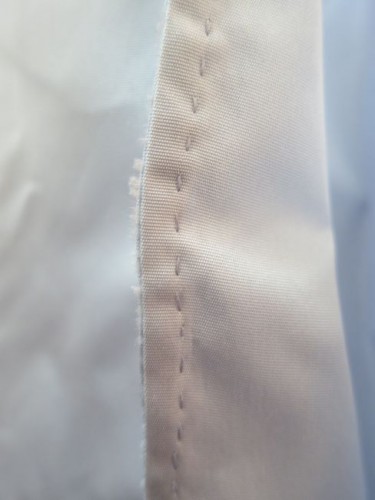
I’ve averaged between 17 & 22 stitches per inch on this petticoat, which I’m rather proud of, especially as the taffeta is extremely tightly woven, and very hard to sew through, even using silk thread (silk thread is so amazing for handsewing. It slips through fabric like butter).
I cut my skirt 105cm long, which was stupid of me, because I forgot to add an extra 20cm or so of length to go over the paniers and fold down at the centre (I’ll show you how I am fixing that in a bit). The hem is faced with a 14cm wide strip of white linen, based on period examples.
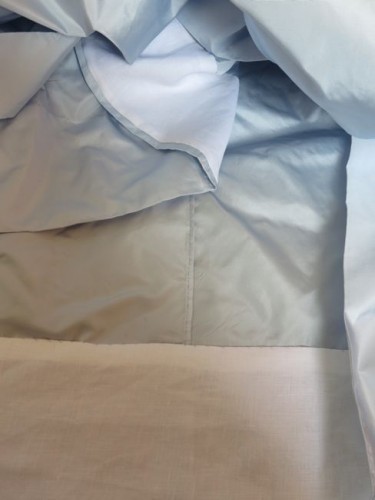
The linen adds a nice bit of stiffness and body to the hem, and will help protect the silk.
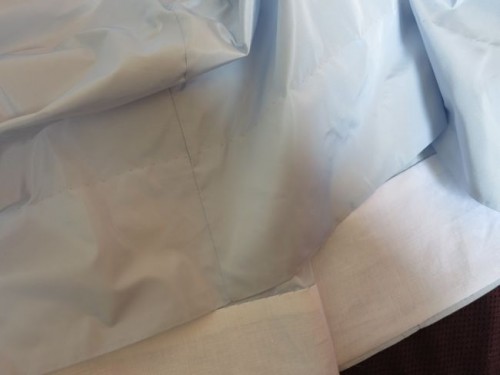
Once my side seams were sewn, and my hem was in, I cut side slits for the pockets, and finished them with a length of straight-cut self-fabric binding.
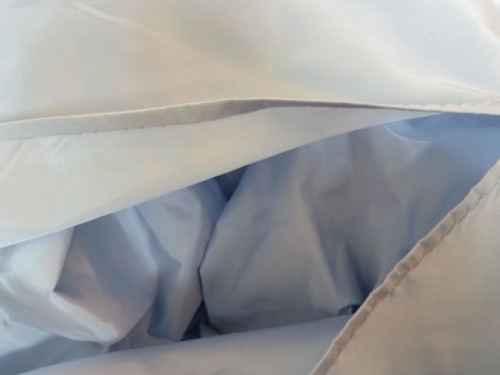
Then I pleated my skirt over paniers and a petticoat on Isabelle, with help from Felicity (scroop is better than catnip where she is concerned. One whisper of frou-frou and she’s on the fabric like lightning).
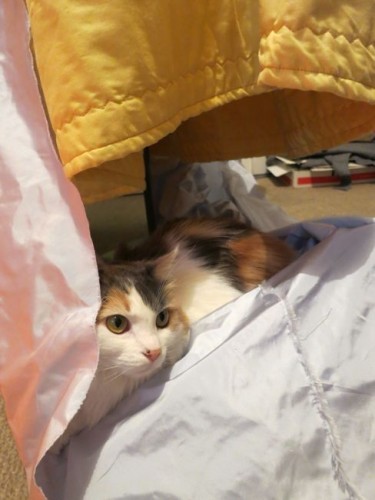
This, of course, is when I discovered I’d cut the petticoat too short. There was a bit of teeth gnashing, and then I had a clever idea. What if I just cut two long triangles for each side of the skirt to be the extra length over the paniers, like so?
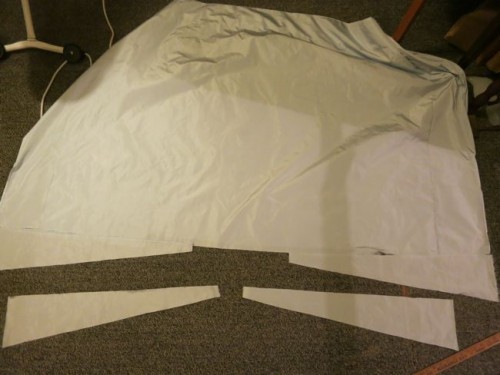
The grainlines will stay the same, the seams won’t show because they are set far enough back from the centre of the skirt and will be covered by the overskirt, and I’ll actually save fabric.
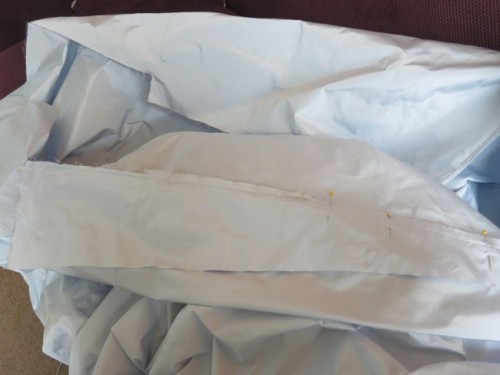
It’s not a technique that I’ve ever seen on a period garment, but it’s so obvious that it’s quite plausible: it would be a simple way to change a petticoat for a different size of paniers, or to alter it to another wearer, and it is a more frugal use of fabric (I’m saving well over 20cm doing it this way).
So that’s my current state of affairs: sewing on long triangles, then to pleat and sew to a waistband, then to add the ruffle. I may not get to the ruffle by Monday. Maybe that will be a tiny soft entry for Lace & Lacing? If it has holes, it’s lacy, right?
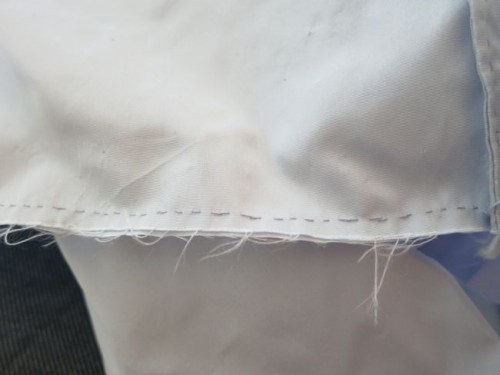
And I’ll leave you with another demonstration of how much my cat loves this fabric:
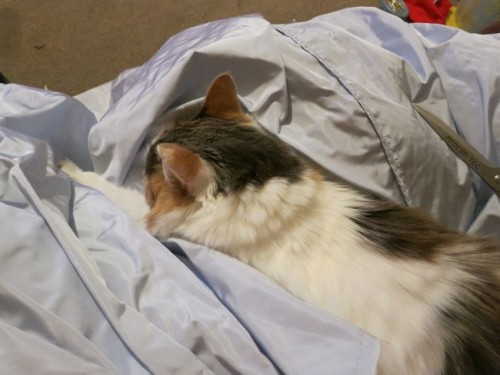

Oooh, I remember seeing this in its early stages the friday before fabric-a-brac, I’m looking forward to seeing the finished product!
Lovely fabric, look forward to seeing the finished item! Still haven’t got my sewing space back so I’m living vicariously.
Thanks! The nice thing about hand sewing is you really don’t need as much sewing space!
That reminds me of Gone With The Wind and the petticoat that was so stiff it could stand alone! That is amazing, though. I can’t wait to see the finished outfit! I was wondering–what did they use to make those lacy holes? Are they actually just cut out, or are the edges bound? It’s rather interesting!
That’s what good taffeta does! The lacy patterns in 18th century ruffles were made with metal punches/stamps – so they are punched, rather than cut, but the edges weren’t bound in any way. Just like the ruffled edges aren’t finished. Good tightly woven fabric didn’t unravel much.
I think the real princess is the one snuggling in the fabric! A friend who knows his stuff told me that sometimes the raw edges were stabilized with gum arabic, although he may have been referring to wool military uniforms.